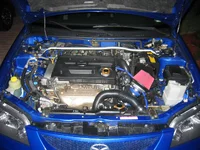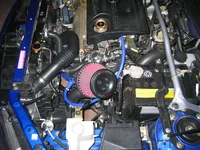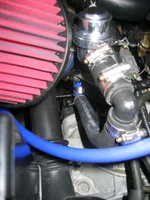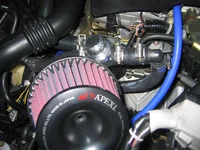Worlds Longest Post
MazdaSpeedSter said:
I'm using the apexi intake power intake filter because I'm not a fan of oil type filters,
starflare21 said:
product looks good but what do you mean by "oil type" filter? isn't the apex one a cotton gauzed one too? do you mean foam type? foam filters are actually supposed to be better flowing then cotton gauze type (stainless mesh would be above that on the list) but do filter less particles then a cotton gauze type. this is one reason HKS uses dual layers.
MazdaSpeedSter said:
HKS is one of the worst... check this out <
http://mkiv.com/techarticles/filters_test/2/ >
The Perrin filter comes with lots of oil on the foam part of the filter. Dirt sticks to the filter, thus clogging it making it harder to get air taking away performance. You may clean it and re-oil, but I prefer just to have a filter such as the apexi, my preference.
starflare21 said:
i guess that vacuum cleaner test on that website beats the stuff i've heard from a friend that has an engine dyno. (dunno) go figure
good article.
Hey guys,
Let me give you some facts about filters .....and then let you decide.
Basic overall issues
Free flowing filter = no dirt filtration
Ultimate dirt filtration = no air flow
What most people want falls somewhere in the middle. Good filtration and maximum power.
Metal mesh filters catch nothing. These filters are like a screen door for your intake. The benefit to these filters is scene at the track. You want as much flow as possible but you don't want to ingest something from under the hood by accident. These filters are not recommended for daily use if you are at all concerned about engine life.
Cotton and gauze mesh trap dirt in a layer of gauze sandwiched between two metal screens. More expensive name brand versions use a higher quality gauze layer compared to cheaper filter copies made overseas. The higher quality gauze traps more dirt but also hinders airflow.
Foam filters
Multiple foam densities and the use of dual and triple layers can make generalistic comparisons difficult. The basis of the design is that you have approx an inch of filter material. The material filters by suspending dirt in oil which clings to the mesh matrix of the foam.
Additional facts
Turbo charged vehicles ingest as much as 10 times the amount of air. This means that the filter has to filtrate 10 times the amount of dirt. This also means that because of the enormous sucking ability of the turbo air turbulence is not a factor.
PERRIN Performance made a choice to step away from main stream filter design/choice. Our experience designing parts for supercharged and turbocharged vehicles has led our company to choose the foam filter design. Our first priority is air filtration. We feel that we offer foam filters add the perfect blend of power and protection for turbo charged vehicles. We will fully admit that you can achieve even more horsepower using a higher flowing filter with your PERRIN intake systems. Our company has chosen a filter product, which we feel, offers superior filtration and excellent power gains. (2thumbs)
As for the MKIV test.
The test seams flawed to me here.a few reasons why.
#1 how were the dirt particles introduced the filters. I see they used a vacuum as the suction source. I can only imagine that they just sprinkled dirt on the filters.
#2 the particular foam filter used here is only about 3/8th of an inch thick. It is only intended for race use and (though noted at the bottom of the page) it does not come coated with an oil media.
#3 there is a distinct flaw/irony when the cotton and gauze filter, which indicated that it trapped all the dirt, also generated the most horse power. Why would either the metal mesh or the foam filter, which obviously allowed the most flow through, not have the largest increase in power?
#4 the last Irony is that foam filters are classically accused of being way to restrictive. This leads into the next point..
This excerpt is pulled direct from K&Ns web siteIronically saying the exact opposite of the MKIV test.
www.knfilters.com said:
Typical foam filters
#1 Lack of surface area hinders air flow and dirt holding capacity. Open cell foam usually saturated with oil.
#2 Dirt builds on outside and blocks the openings.
#3 Higher vacuum pressures distort the cells drawing dirt deeper into the filter.
#4 Airflow is reduced as cells become blocked.
This is miss information too.
-Though foam filter have a smaller outer surface area they, unlike cotton and gauze filters, can trap dirt anywhere within the entire thickness of the filter. The working area" of the filter is actually much larger then cotton and gauze.
-#2 is laughable. I think that this must be a misprint. This is actually a flaw with the cotton and gauze filter. As the filter gets dirty the dirt blocks pores reducing flow. Because a foam filter traps dirt within the entire filter it will have the same flow rates after thousands of miles of use. Even in extreme dirt situations.
The point. Finally
We do not manufacture air filters. We have air filters custom made to our specifications based on the vehicles we manufacture parts for. Every style of filter is available to us as options for our company to use. I hope that the information I have laid out above reinforces our choice to use foam filters. Very high rate of filtration, good horspower number, and a new distinct look. We have made the decision and will continue to use foam filters with our products.
If you have any further questions or concerns our sales staff would be happy to speak with you.
PERRIN Performance
1.503.643.4677
Ps. Since i started writing this response this thread has grown. I will answer try to answer all of your concers tommorro.
cheers.
(cheers2)




